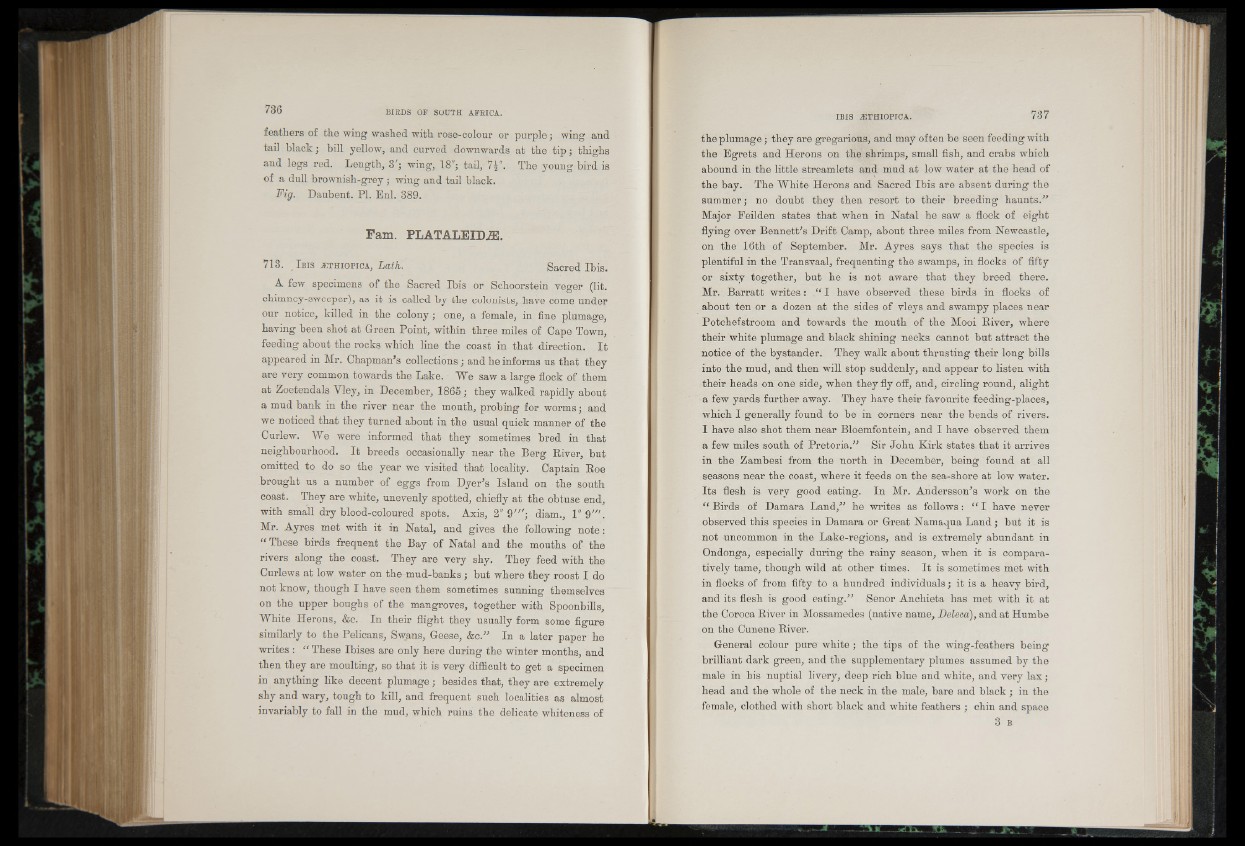
feathers of the wing washed with rose-colour or purple; wing and
tail black; bill yellow, and curved downwards at the tip ; thighs
and legs red. Length, 3'; wing, 18"; tail, 7|". The young bird is
of a dull brownish-grey; wing and tail black.
Fig. Daubent. PI. Enl. 389.
Fam. PLATALEIDiE.
713. I bis a ith iop ica , Lath. Sacred Ibis.
A few specimens of the Sacred Ibis or Schoorstein veger (lit.
chimney-sweeper), as it is called by the colonists, have come under
our notice, killed in the colony; one, a female, in fine plumage,
having been shot at Green Point, within three miles of Cape Town,
feeding about the rocks which line the coast in that direction. I t
appeared in Mr. Chapman’s collections; and he informs us that they
are very common towards the Lake. We saw a large flock of them
at Zoetendals Vley, in December, 1865; they walked rapidly about
a mud bank in the river near the mouth, probing for worms; and
we noticed that they turned about in the usual quick manner of the
Curlew. We were informed that they sometimes bred in that
neighbourhood. It breeds occasionally near the Berg River, but
omitted to do so the year we visited that locality. Captain Roe
brought us a number of eggs from Dyer’s Island on the south
coast. They are white, unevenly spotted, chiefly at the obtuse end,
with small dry blood-coloured spots. Axis, 2" 9'"; diam., 1" 9'".
Mr. Ayres met with it in Natal, and gives the following note:
“ These birds frequent the Bay of Natal and the mouths of the
rivers along the coast. They are very shy. They feed with the
Curlews at low water on the mud-banks; but where they roost I do
not know, though I have seen them sometimes sunning themselves
on the upper boughs of the mangroves, together with Spoonbills,
White Herons, &c. In their flight they usually form some figure
similarly to the Pelicans, Swans, Geese, &c.” In a later paper he
writes : “ These Ibises are only here during the winter months, and
then they are moulting, so that it is very difficult to get a specimen
in anything like decent plumage; besides that, they are extremely
shy and wary, tough to kill, and frequent such localities as almost
invariably to fall in the mud, which ruins the delicate whiteness of
the plumage; they are gregarious, and may often be seen feeding with
the Egrets and Herons on the shrimps, small fish, and crabs which
abound in the little streamlets and mud at low water at the head of
the bay. The White Herons and Sacred Ibis are absent during the
summer; no doubt they then resort to their breeding haunts.”
Major Feilden states that when in Natal he saw a flock of eight
flying over Bennett’s Drift Camp, about three miles from Newcastle,
on the 16th of September. Mr. Ayres says that the species is
plentiful in the Transvaal, frequenting the swamps, in flocks of fifty
or sixty together, but he is not aware that they breed there.
Mr. Barratt writes : I have observed these birds in flocks of
about ten or a dozen at the sides of vleys and swampy places near
Potchefstroom and towards the mouth of the Mooi River, where
their white plumage and black shining necks cannot but attract the
notice of the bystander. They walk about thrusting their long bills
into the mud, and then will stop suddenly, and appear to listen with
their heads on one side, when they fly off, and, circling round, alight
a few yards further away. They have their favourite feeding-places,
which I generally found to be in corners near the bends of rivers.
I have also shot them near Bloemfontein, and I have observed them
a few miles south of Pretoria.” Sir John Kirk states that it arrives
in the Zambesi from the north in December, being found at all
seasons near the coast, where it feeds on the sea-shore at low water.
Its flesh is very good eating. In Mr. Andersson’s work on the
“ Birds of Damara Land,” he writes as follows: “ I have never
observed this species in Damara or Great Namaqua Land; bat it is
not uncommon in the Lake-regions, and is extremely abundant in
Ondonga, especially during the rainy season, when it is comparatively
tame, though wild at other times. It is sometimes met with
in flocks of from fifty to a hundred individuals; it is a heavy bird,
and its flesh is good eating.” Senor Anchieta has met with it at
the Coroca River in Mossamedes (native name, Deleca), and at Humbe
on the Cunene River.
General colour pure white ; the tips of the wing-feathers being
brilliant dark green, and the supplementary plumes assumed by the
male in his nuptial livery, deep rich blue and white, and very lax;
head and the whole of the neck in the male, bare and black; in the
female, clothed with short black and white feathers ; chin and space
3 B